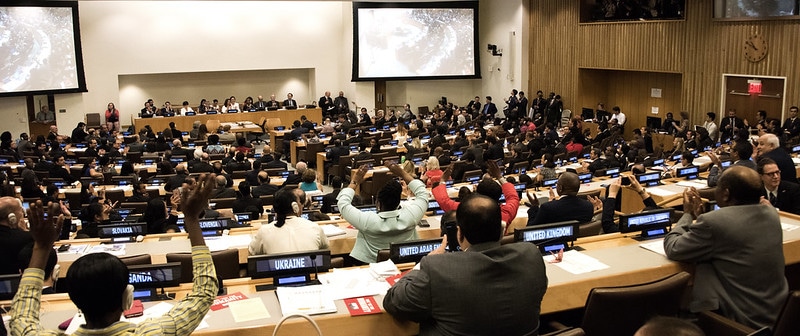
Why the United States should support the Treaty on the Prohibition of Nuclear Weapons
Posted: 24th January 2021
From the Bulletin of the Atomic Scientists
By William J. Perry | January 22, 2021

Moment of the adoption of the Treaty on the Prohibition of Nucler Weapons, July 7, 2017. (Photo: Clare Conboy/ICAN)
Almost 14 years ago, I joined George Shultz, Henry Kissinger, and Sam Nunn to call for a world free from nuclear weapons. Our bipartisan coalition represented the top tiers of the American government during the Cold War, and our first-hand knowledge of nuclear weapons during that time convinced us that our call to action was not only possible, but necessary.
We likened this monumental task to scaling an uncharted mountain; to many it may seem impossible, and the top too far beyond our view to see. Yet standing still or sliding down the mountain could lead to the end of human civilization. We must chart a course to higher ground.
In our statements, we outlined practical steps that we could take to move up the mountain. But at the heart of our proposal was the vision of the mountaintop. We need both the vision, and the steps to realize that vision. For 75 years, we have allowed the idea of mass destruction to be normalized as a necessary component of our international security strategy. If we are ever going to reach the top of the mountain, we must recognize that nuclear weapons are, as Ronald Reagan described them, “totally irrational, totally inhumane, good for nothing but killing, possibly destructive of life on Earth and civilization.”
In our op-eds, we called for the need to build a worldwide consensus to address nuclear dangers. Recently, a major milestone has been achieved towards that end. In October 2020, the United Nations Treaty on the Prohibition of Nuclear Weapons was ratified by Honduras, the 50th country to do so. As a result, the treaty enters into international law January 22. The treaty was largely the result of work by the International Campaign to Abolish Nuclear Weapons, which received the Nobel Peace Prize for those efforts in 2017. I salute them for their accomplishment.
Many in the field of international security have denigrated this accomplishment as insignificant, since nuclear-armed nations have not recognized this treaty. But my friend, the late Max Kampelman, would have had an answer to this cynicism. Max, who was a major inspiration for the op-eds that the four of us published, talked about the “Power of the Ought,” noting that the principles articulated in the Declaration of Independence conflicted with the reality at the time, notably slavery and the disenfranchisment of women. But our democracy has been a journey from the “is” to the “ought,” as we continue the work to form a “more perfect union.” As Max once said, “The elimination of nuclear arms is an ‘ought’ that should be proclaimed and energetically pursued.”
When the United States signed the Nuclear Non-Proliferation Treaty in 1968, we agreed to the terms in Article VI, obligating us to “pursue negotiations in good faith…on a treaty on general and complete disarmament.” However, we and other nuclear powers have failed to uphold our obligation to the NPT, a failure which the ban treaty is working to correct. The ban treaty rightly establishes abolition as the standard that all nations should be actively working to achieve, rather than an indeterminate future goal.
The Treaty on the Prohibition of Nuclear Weapons is a significant step forward, toward the future we imagined 14 years ago. It creates a bold vision of a nuclear weapons-free world, shifting our focus to the inhumane aspect impact of these weapons and proclaiming a global consensus to address this existential issue. The ban treaty strives to bring our global perception of nuclear weapons closer in line with their terrible reality and formally enshrines the necessity of their total elimination for the good of humanity.
While the treaty alone is not sufficient to bring about the end of nuclear weapons, it establishes key ideals necessary to push us further up the mountain. It offers inspiration to combat the sense of hopelessness that many feel when confronting this daunting problem. It serves as a new instrument of non-proliferation, augmenting the existing Non-Proliferation Treaty. It offers powerful support to those arguing against modernizing and expanding nuclear arsenals, actions that will now fail to follow the international law that most countries have agreed to live by. The treaty won’t end nuclear weapons any time soon, but it represents an important step in that direction.
The United States signed the Nuclear Non-Proliferation Treaty in 1968. At the Reykjavik Summit in 1986, President Reagan made the case for eliminating these weapons. And in 2009, President Obama pledged that the United States would “seek the peace and security of a world without nuclear weapons.” Now in 2021, a treaty has come into force that makes nuclear weapons illegal for all who sign it. America prides itself on being a nation of trailblazers; let us be the first nuclear-armed nation to blaze this new trail toward the top of the nuclear-free mountain.